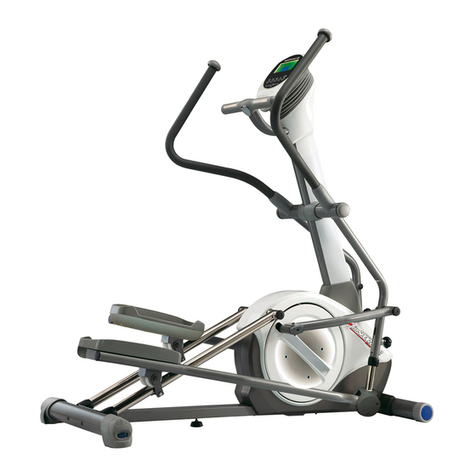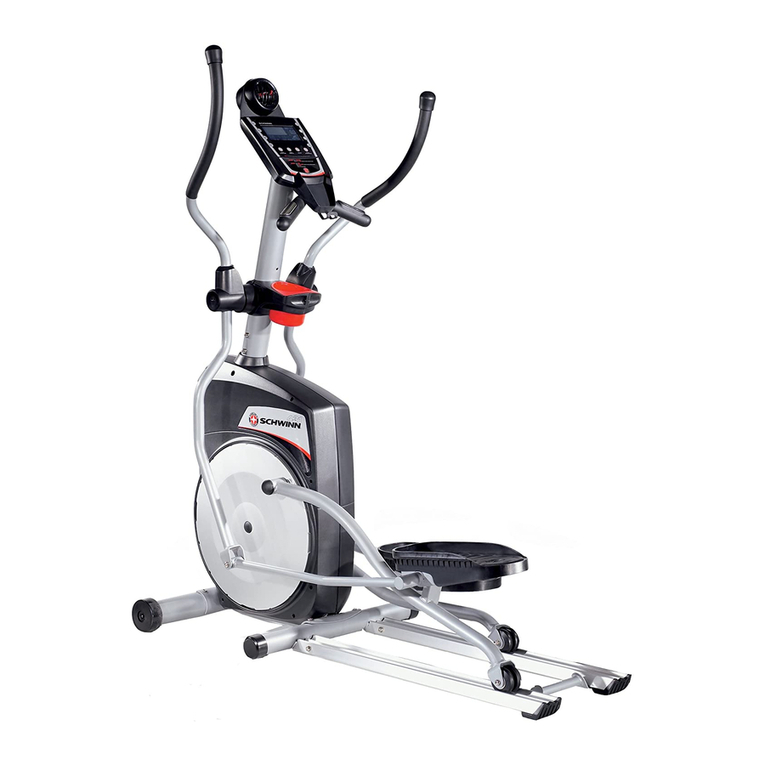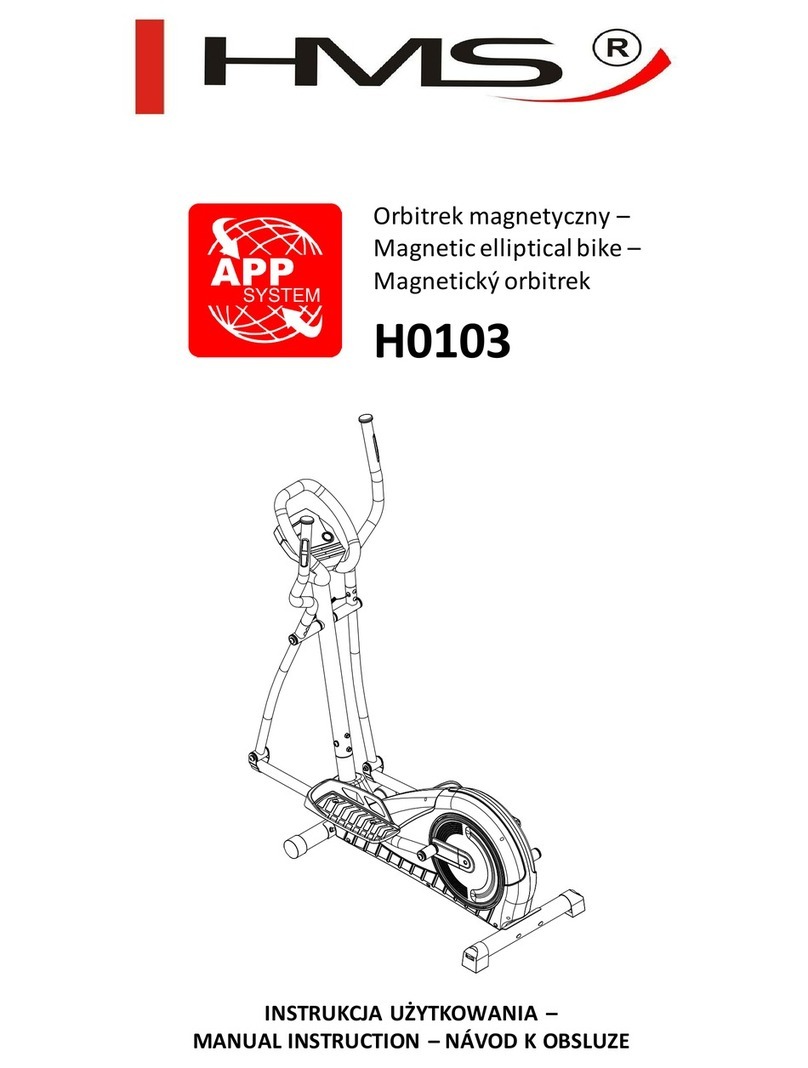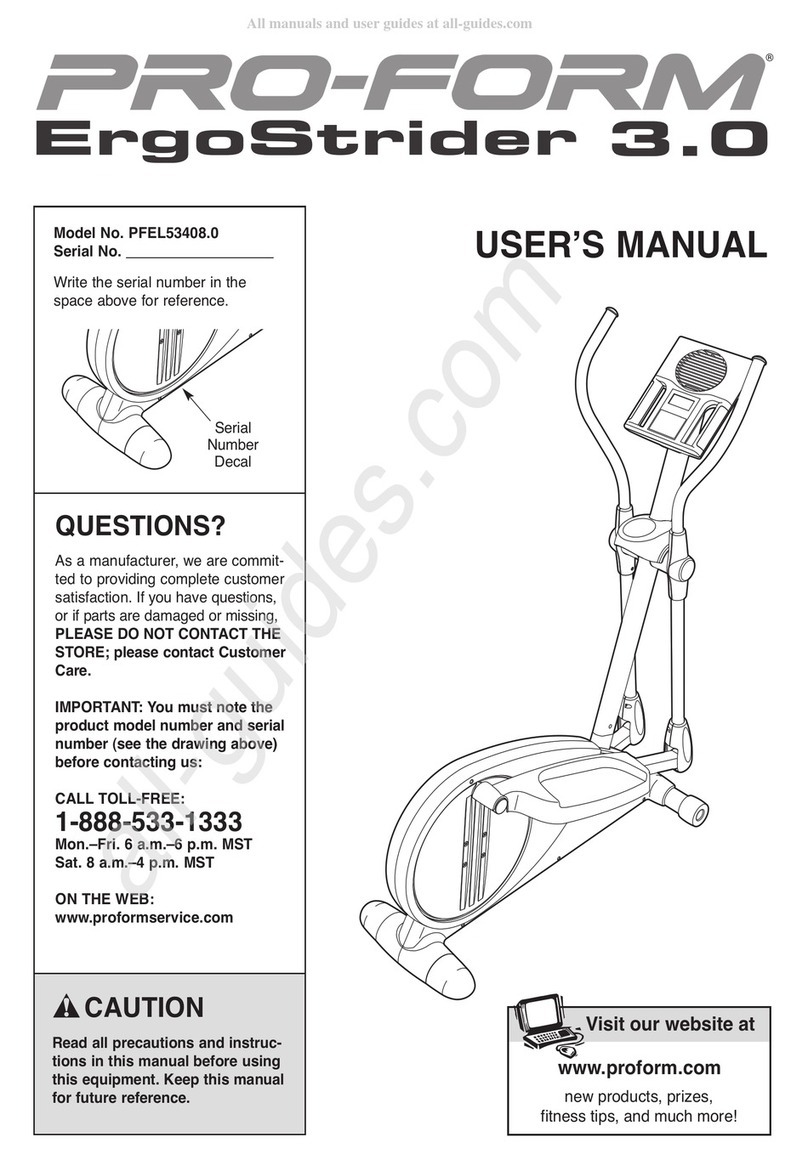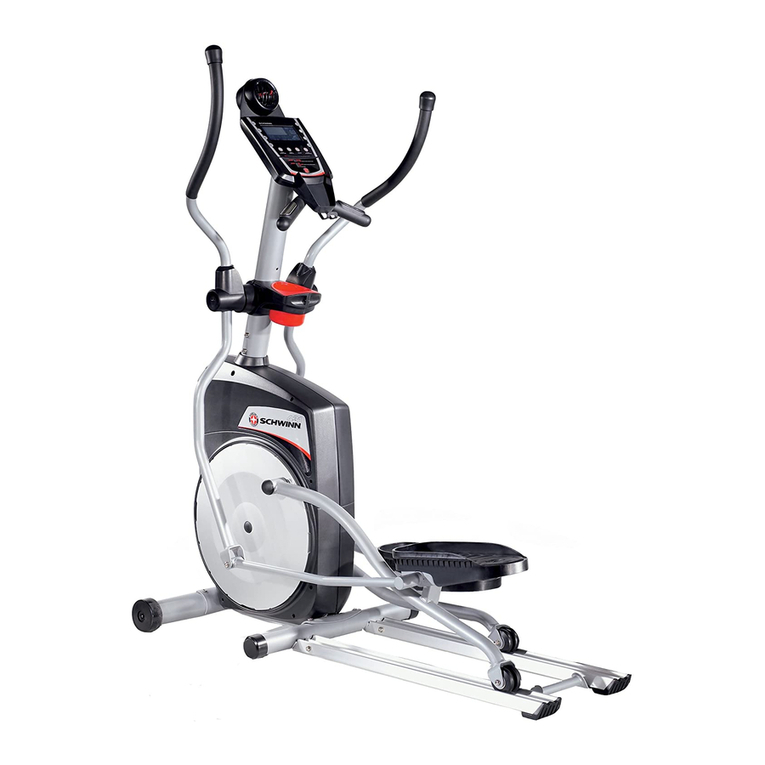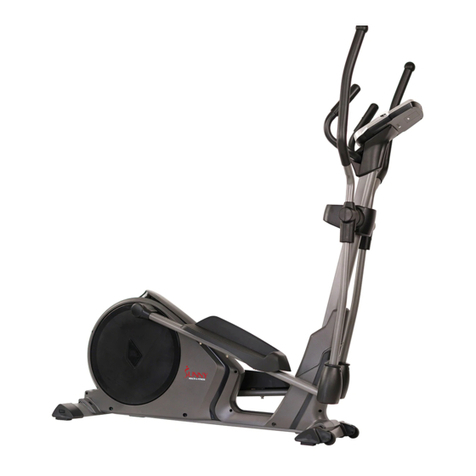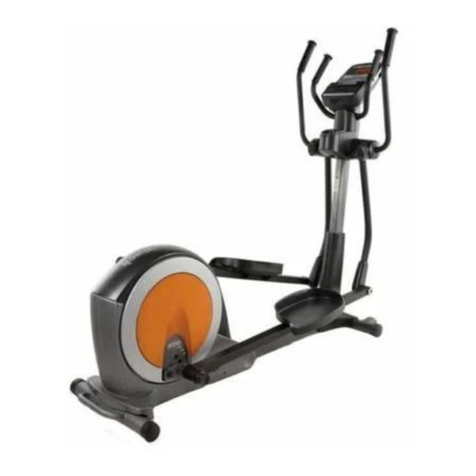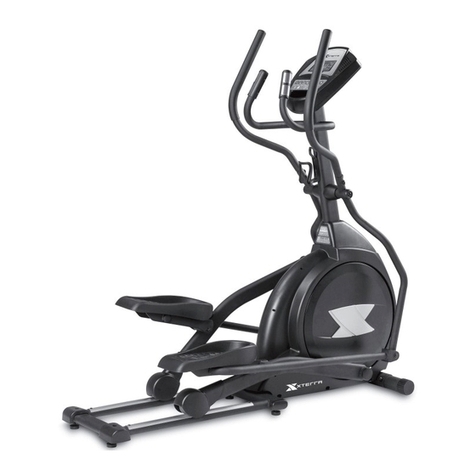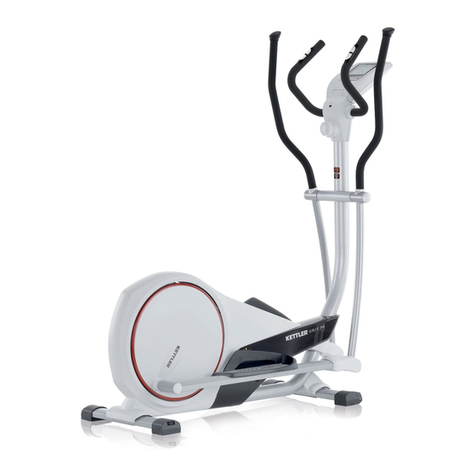Hang ups Teeter F5000 User manual

U.S. and foreign patents apply. Other foreign patents pending.
OWNER'SMANUAL
PRIOR TO USE
Make sure that the table rotates smoothly to the fully inverted position and back, and that all fasteners are secure.
Make sure the user settings described below are properly adjusted for your unique needs and body type. Take your time
finding your proper settings and REMEMBER THEM. Check these settings every time prior to using the equipment.
1. Adjust the Roller Hinge:
Therollerhingesettingcontrolstheresponsivenessorrateofrotation. There
arethree holes;hole selectiondepends bothon yourbody weightand the
rotational responsiveness you desire. For users just learning to use the
inversiontable, werecommend startingwithSetting C. (SeeFigure1)
IMPORTANT: Place the roller hinges in the same hole setting on each side.
F5000TM &
F6000TM Height / Weight Capacity:
Max 6'6" / 300 lbs. (198 cm, 136 kg)
It is your responsibility to familiarize yourself with the proper use of the equipment and the inherent risks of inversion, such as falling on
your head or neck, pinching, entrapment or equipment failure. FAILURE TO FOLLOW INSTRUCTIONS OR HEED WARNINGS COULD
RESULT IN SERIOUS INJURY OR DEATH.
Restrictions on Use
•DO NOT use the equipment without a licensed physician's approval. Carefully review the following list of medical
contraindications for inversion with your licensed physician: (This is not an exhaustive list, it is intended only for reference)
· Middle ear infection · Conjunctivitis · Recent stroke or transient ischemic attack
· Extreme obesity · High blood pressure · Bone weakness (osteoporosis)
· Pregnancy · Hypertension · Recent or unhealed fractures
· Hiatal hernia · Heart or circulatory disorders · Medullary pins
· Ventral hernia · Spinal injury · Surgically implanted orthopedic supports
· Glaucoma · Cerebral sclerosis · Use of anticoagulants (including high doses of aspirin)
· Retinal detachment · Acutely swollen joints
•DO NOT use if you are over 6'6" (198 cm) or 300 lbs. (136 kg). Structural failure could occur or head/neck may impact the floor
during inversion.
•DO NOT modify the equipment or use accessory attachments that are not recommended by the manufacturer. Utilize the
equipment for its intended purpose only.
Precautions Before Using
•DO NOT use the inversion table until you have thoroughly and carefully read the Owner's Manual, viewed the Instructional Video,
reviewed all other accompanying documents, and inspected the equipment.
•NEVER allow children to use the equipment unsupervised.
•DO NOT operate equipment while under the influence of drugs, alcohol, or medication that may cause drowsiness or disorientation.
•ALWAYS inspect the equipment prior to use. Make sure that all fasteners are secure and that the equipment is located on a level
surface.
•ALWAYS wear securely tied lace-up shoes with a flat sole, such as a normal tennis style shoe. DO NOT wear shoes with thick
soles, boots, high-tops or any shoe that extends above the anklebone.
•ALWAYS make sure the equipment is properly adjusted to the correct user settings prior to each use.
• Refer to additional warning notices posted on the equipment.
Precautions During Use
•DO NOT use aggressive movements, or use weights, elastic bands or any other exercise or stretching device while on the
inversion table.
•ALWAYS keep hands and fingers away from moving parts to avoid injury. DO NOT drop or insert objects into any opening.
• First time users should use a spotter to ensure they are able to find the correct balance setting and are comfortable with the
operation of the table.
• This product is not intended for use in public facilities.
WARNING
Figure 1
DO NOT REMOVE FROM TABLE
!
A
B
C

4. Adjust Foot Platform:
Adjust the foot platform so that when standing on it the foam ankle clamps will secure down onto the smallest part of your
ankles,immediately abovetheanklebone(carefullyread the"MountingandSecuringYour Ankles"sectionbelow). Properly
adjusting the foot platform will help to ensure the most secure hold while you invert.
• Slidethe mainshaftuntil thelastsetting youcan readis1" morethanyour height.e.g.If you're
5'10"(178cm)thelastnumbersyou'llbeabletoreadwillbe5'11"(180cm).NOTE:Thebestheight
settingforyouwilldependonyourweightdistributionandcouldvaryoneortwoinchesoneither
sideofyouractualheight.Startingatoneortwoinchesmorethanyourheightwillhelptoensure
that the rotation of the table is not too fast.
• Releasetheheightselectorlockingpinsothatitfullyengagesinahole. Retightenthede-rattlerknob.
3. Attach Tether Strap:
For first time users, attach the tether strap to help control your angle of rotation. (See Figure 3)
You can increase the angle of rotation allowed by the tether strap as you become more
comfortableusingthetable,orremoveitall-togetherforfullinversion.
Figure 2
Figure 3
MOUNTING AND SECURING YOUR ANKLES
1. Preparing to Mount:
•ALWAYS wear securely tied lace-up shoes with a flat sole, such as a normal tennis style shoe.
DO NOT wear shoes with thick soles, boots, high-tops or any shoe that extends above the
anklebone,asthis typeoffootwearcould interferewithproperlysecuring yourankles.
• Confirm that the foot platform is adjusted properly so that the ankle clamps fit snug against the
smallestpartof theankle,immediatelyabove theanklebone.
2. Mounting:
• Stand on the foot platform, sliding your ankles between the foam ankle clamps.
• Press your ankles back firmly against the rear ankle clamps.
• Rotate the top of the rear clamps slightly inward toward your ankles - this will increase your comfort while inverting.
• Pull out the locking pin to allow the front ankle clamps to snap closed against your ankles. Make sure your pant legs do
notinterferewithobtainingasecureclosure.
• Adjust the front ankle clamps to make sure both the front and rear ankle clamps are snug against your ankles. (See
Figure 4) Release the locking pin so that it fully engages a hole setting. (See illustrations below)
• If the locking pin does not automatically engage in a hole, push the front ankle clamps inward until the pin engages fully
in the next tightest hole setting. Verify that no part of the footwear or garments can touch or interfere with the locking pin
inanywayduringinversion.
• Use the concept of HEAR - FEEL - SEE every time you secure your ankles:
HEAR the locking pin click into place.
FEEL the locking pin to make sure it is fully engaged in a hole setting.
SEE that there is NO space between the locking pin and its base.
Owner's Manual LF5200 Pg. 2
WARNING
!
Failure toengage theankle locking pin fullycould resultin seriousinjury ordeath! DO NOT deviate from these instructions.
CORRECT:
LOCKINGPIN
FULLYENGAGED
DANGER:
LOCKINGPINNOT
FULLYENGAGED
2. Adjust Height Setting:
The height settings are stamped on the main shaft in both inches and centimeters.
• Loosenthede-rattlerknob.
• Pullouttheheightselectorlockingpinwithyourrighthandwhileslidingthemainshaftwithyour
left. (See Figure 2)
Figure 4

INVERTING
Reviewtheinsert"ImportantDetailsRegardingInverting"
If correctly balanced, the inversion table will operate much like a teeter totter. By
shifting weight to the head end of the table, you will move in that direction, and vice
versa. Your arms will provide most of the weight needed to rotate the table.
Fasteningthetetherstrapbeforeyou startwillprevent the tablefrom inverting
completely. (SeeFigure 6)
• Raiseone armslowly upand overyour head,stopping along the way as required
to control the downward rotation of the table. If you raise both arms, the speed
andangleofinversionincreases.
• When the table is at an angle you like, rest your arm on the table at whatever
position it's in.
RETURNING UPRIGHT
• To return to the upright position, put your arms at your side. (See Figure 7) Since
yourbodymayhavelengthened, armmovements alonemaynot besufficient to
return you to the full upright position. You may need to bend your knees to shift
your body weight to the foot side of the pivot point. Do not lift your head or try to sit
up. (See Figure 7A)
BALANCING
Theinversion tableis like asensitively balancedfulcrum. Itresponds tovery smallchangesin
weight distribution. As a result, you must always test to make sure you have the correct height
setting. Ensure that there is clearance to rotate without contacting other objects or people.
• Rest your head on the nylon mat and place your arms at your side. Slowly place your arms
on your chest.
⇒Ifyour headislower thanyour feet,lengthenthe heightsetting byonehole andtest again.
⇒If your feet do not move at all, then shorten the height setting by one hole and test again.
⇒Ifthe table comesto restwith yourfeet lifted a few inchesoff theA-frame, youhave found
the correct balance setting! (See Figure 5)
The correct balance setting will allow your arm movements to rotate the table backward smoothly and slowly and to return to
the full upright position. This is an important step, so you should spend as much time as you need to find your ideal height
setting. Once you do find your setting, it should remain the same as long as your weight does not change substantially.
Figure 5
Correctly
Balanced
FULL INVERSION
Definition: Hanging completely by your ankles with your back free from the table.
Do not attempt this step until you are comfortable with partial inversion.
• Disconnect the tether strap.
• Set roller hinges in the top hole setting "A" if you want the table to "lock" firmly
while inverted. If you are 220 lbs. (100 kg) or more, set the roller hinges in the
"B" hole setting.
• From a balanced position on the table, slowly raise both hands over your head to
begin rotation. You may need to assist the last few degrees of rotation by
pushing on the floor or A-frame until the table pulls away from your back. In your
correct balance setting, your weight will keep the table "locked" in this position
until you are ready to return upright. (See Figure 8)
Figure6
WARNING
!
For your first few inversion sessions, ask a spotter to assist you until you are able to find your correct balance setting and
arecomfortablewiththeoperationofthetable.
Do not use the hand grips to rotate the table. They are for mounting and
dismounting; they are not a substitute for finding your correct balance setting.
Figure8
Bend Knees
Slightly
Figure7A
Figure7
Owner's Manual LF5200 Pg. 3

Figure10
Storage
Owner's Manual LF5200 Pg. 4
To Release from the Inverted "Locked" Position:
• Placeonehandoveryour shoulderandhold ontothe corner ofthe tableframe.
• Place your other hand on the bottom bar of the A-frame in front of you. (See Figure 9)
• Pull both hands together. This will rotate the table out of the "locked" position. Slowly
move your arms and elbows to your sides to complete the rotation. Elbowsprotruding
overthe sidesof the tablebed couldgetpinched betweentheA-frame andthetablebed
asyoureturnupright (SeeFigure9A).
• If your body is stretched, you will need to bend your knees to shift body weight to the
foot side of the pivot point. Do not lift your head or situp while releasing from the
"locked" position.
STORING THE INVERSION TABLE
• Loosenthede-rattlerknob.
• Pull out the main shaft locking pin and slide the main shaft in all the way to the ankle
clamp assembly. Allow the locking pin to engage in the storage setting.
• Rotate the table opposite from use until the table has turned 180 degrees and rests
againstthe cross baron theA-frame.
• Foldthe legsofthe A-framebasetogether forcompactstorage. (SeeFigure 10)
Takecare notto pinchyourfingers.
For information about the Teeter Hang Ups®5-year warranty, or if you have any problems
assembling the equipment or questions about its use, please contact Customer Service at
the appropriate location below:
* any modification to this device
will void the UL Classification
Classified as Medical
Equipment, part I in accordance
with UL 2601-1 and CAN/CSA
C22.2; General Requirements
for Safety in accordance with
Underwriters Laboratories, Inc.
U.S.andforeignpatentsapply. Otherforeignpatentspending.
TeeterHangUps®isaregisteredtrademarkofSTLInternational,Inc.
andInversionInternational,Ltd.
Specificationssubjecttochangewithoutnotice.
©COPYRIGHT2004,STLInternational,Inc.
InternationalLawProhibitsAnyCopying,04/04-10
USA & Canada:
STL International, Inc.
9902 162nd St. Ct. E., Puyallup, WA98375
Toll Free (Phone) 800-847-0143 (Fax) 800-847-0188
Local (Phone) 253-840-5252 (Fax) 253-840-5757
International:
Inversion International, Ltd.
PO Box: AP 59245, New Providence Island, Bahamas
(Phone) +1-242-362-1001
(Fax) +1-242-362-1002
For additional languages in Spanish, French, Dutch, German, Italian or Portuguese, please contact customer service.
WARNING - Tipover Hazard
The equipment is structurally rated at a capacity of 6'6" (198 cm) or 300 lbs (136 kg). However, please confine all inverted
activities to smooth movements. Aggressive exercises, which involve a lot of body movement, can cause the table to tip over
resulting in serious injury or death!
!
WARNING
It is your responsibility to familiarize yourself with the proper use of the equipment and the inherent risks of
inversion, such as falling on your head or neck, pinching, entrapment or equipment failure.
DO NOT use the inversion table until you have thoroughly and carefully read the Owner's Manual, viewed the
Instructional Video, reviewed all other accompanying documents, and inspected the equipment. ALWAYS test
and inspect the equipment for smooth operation prior to each use.
!
Figure9A
Figure9

IMPORTANT DETAILS REGARDING INVERTING
Begin Slowly:
• Invert only15 -20 degreesto begin with. Thehand
gripsfeatureengravingsthatillustratethe body
position at 0°, 30°, 60°, & 90°.
• Staydown aslong asyouare comfortable,even if
only a few seconds at first.
Pay Attention to What Your Body Tells You:
• Remind yourself that your body is unique and it will tell you what is good for it.
• Come up slowly, dizziness after a session is a sign that you have come up too
fast. Important: rest at horizontal for 30 seconds or more, allowing your body
to readjust to being upright.
• Waitforawhileafteryou'veeatenbeforeyouinvert.
• If inversion makes you nauseous, don't fight it. Come up as soon as you feel queasy, even if after only a few seconds.
Give it time--it may take weeks or months before your inner ear gets used to inverting.
Make Changes Gradually:
• Increase the angle in small increments only if it is comfortable to you. You can gain all the benefits of inversion without
everinverting beyond60 degrees. Musclestretching and relaxation can be realized atas littleas 20degrees.
• You may want to increase your routine from 1-2 minutes to 5 or more over time - just listen to your body. Remember,
this is not a no pain, no gain situation!
Moving While Inverted is Helpful:
• Addgentlestretchingandlightexercises onlyafteryou are comfortablewithinversion. Movement whileinvertedmay
help make inversion a more comfortable experience and may help joints to realign and muscles to stretch and relax.
• Movement may be accomplished either by intermittent or rhythmic traction or by stretching and light exercise*:
Intermittent traction consists of 1-2 minutes down and a half minute up, to be repeated as long as
iscomfortable atanglesthat arecomfortablefor you.
Rhythmic traction is a more evenly spaced rocking up and down.
Stretchingcanbe doneatpartial inversion(torsorotation) or atfull
inversion(torsorotation,backextensionandflexion).
Lightexerciseshouldonlybeperformedfromthefullyinverted,"locked"
position. Crunches,full-rangesit-upsandsquats providea greatway to
strengthen muscles with virtually no loads to your joints.
Keepelbows closetothebodywhileexercisingto avoidimpact
withthe A-frame. DO NOT useweights,elasticbandsor any other
exerciseorstretchingdevicewhileontheinversiontable. Confine
allinvertedactivitiestosmoothmovements. Aggressiveexercises,
which involve a lot of body movement, can cause equipment to
tipover resulting in seriousinjuryordeath.
Do It Regularly:
• Makeinversionaregularroutineandintegralpartofyourlife...that
is how you will experience the most benefits!
©COPYRIGHT2004,STLInternational,Inc.
InternationalLawProhibitsAnyCopying,04/04-10

INVERSION: YOUR WAY TO A BETTER BACK, BETTER BODY.
Inversion puts gravity to work for you by placing your body in line with the downward force of gravity. Not only can
inversion therapy help to temporarily relieve back pain, but it also can be used as a method to relieve other negative
effects thatgravityhas onyourbody. Inversion can alsobe used asaproactive approachtohelp maintainoverallback
health. Hangingupside downcanhelp tostretchand relaxmuscles, reduce stress,and providehealthymovement for
ligaments.
•Inversiontemporarilyelongates the spine,increasingthespacebetween thevertebrae, whichrelievesthepressure
on discs, ligaments and nerve roots. Less pressure means less back pain.
•Lyingdown inbedonly releases75% ofstandingbody weightonthe spinaldiscs. The hundredsofligaments and
muscles that encase and stabilize the spine act like a bunch of rubber bands holding the spine in compression
equal to 25% of standing body weight. Inverting to 60° helps to reduce the disc pressure to at or near zero.1
•Theinnercore ofyourdiscs ismadeofjellylike materialwhichprovides the “cushioning”inyour back. You canlose
up to .5” - .75” (1.3-2.0 cm) in height daily during your waking hours from the compressive effects of gravity. This
dailyheight lossreverses overnight,but not100%,resulting inpermanent heightloss, lossof flexibilityandshock
absorption. Whileinverted, youareable to temporarily reversethedownward pressureon yourdiscs,helping the
discs to recover and regain lost moisture and lost height, with improved flexibility.
•Inverting yourself to as little as 20-25° for even a few minutes can help relax tense muscles and speed the flow of
lymphatic fluids which flush out the body’s wastes and carry them to the blood stream.
•Unlike the cardiovascular system, the lymphatic system has no pump. Only the alternate contraction and relax-
ation of muscles moves lymphatic fluid “uphill” through capillaries and one-way valves to the upper chest for
cleansing. Inverting the body so that gravity works with, not against, these one-way valves stimulates the flow of
the lymph system, helping to clear toxins from the body.
•Yourheart must workagainstgravity topumpblood uptoyour brain,whichis the
body’slargest consumer ofoxygen. Inversion isa simpleway toimprove circu-
lation to the upper body.
•Wheninverting,you arehelpingyourheart toclearthe blood fromyourfeet, legs,
and lower body. This allows the blood in your limbs to circulate more easily,
whichmay helptodrain bloodfrom varicoseveins.
Theconstant pullof gravityhas acumulativenegative effecton thejoints andspinal
discs. Used sensibly, inversion is extremely beneficial, and no more dangerous
thanmany otherpopular andwidely-practiced fitnessactivities. Sometimes there’s
anexplanation forwhy inversionworks andsometimes there isn’t.
Theexperience ofthousands ofpeople who invertregularly isthat itgives themthe
relief from back pain they’ve been looking for. Just as important, they gain the
rejuvenatingeffects ofinversionon theentirebody,providing healthbenefitsfar
beyondthe reliefof backpain.
1Nachemson, A and Elfstrom, G; Intravital Dynamic Pressure Measurements in Lumbar Discs. Scandinavian
Journal of Rehab Medicine, supplement, 1970)
©COPYRIGHT2004,STLInternational,Inc.
InternationalLawProhibitsAnyCopying,04/05-10
This manual suits for next models
1
Table of contents

